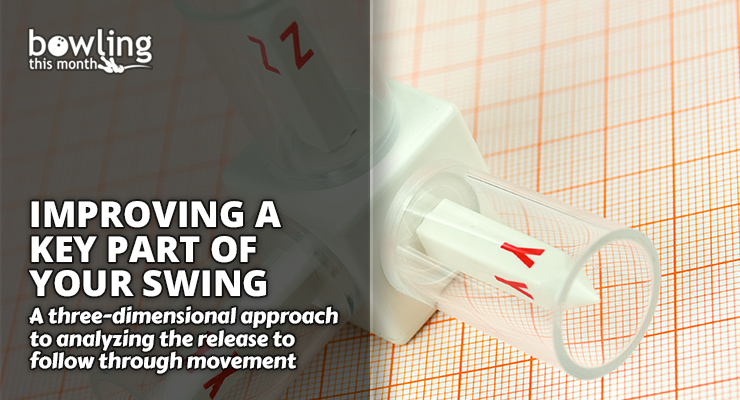As a coach, I have worked diligently to identify cause-and-effect sequences, especially within the context of analyzing energy production and efficiencies in the physical game. This article continues this pursuit by focusing on a more thorough evaluation of the release to follow through (RtFT) phase of the swing. With this in mind, I introduce a three-dimensional analysis perspective of the release to the follow through phase.
Through the experiences of facilitating thousands of lessons over decades of working with bowlers around the world, I believe that many bowlers are not reaching their full potential because their RtFT moves off of the intended target line, leading to a reduction of energy transfer and a loss of accuracy. And, the higher the level, the more vital this phase of the swing becomes. To illustrate, when working recently with an elite bowler, we were able to achieve hand and forearm travel down the intended target line with an adjustment of torso movement. Before this adjustment, the bowler’s RtFT was approximately 10 degrees out of alignment.
In a sport where one shot over a full week of bowling can cost a bowler a tournament cut, a loss of a check, or a failure to medal, maximizing energy transfer and accuracy is literally serious business. To reach one’s full potential, each bowler should strive to improve their release to follow through direction. With a commitment to understanding and addressing the root cause and effect, a bowler can improve their RtFT direction, leading to increased repeatability, improved energy transfer, and better accuracy.
Maximizing energy transfer and accuracy
I start with a straightforward three-pronged premise that will drive the article and the analysis of the RtFT phase. Specifically, my hypotheses are:
- The longer the hand travels on the intended target line, with the fingers in the bowling ball, the more energy transfer there will be from the bowler to the bowling ball, and the more accurate the bowler will be.
- This extended travel length on the same line will also increase the arc distance the fingers travel in the bowling ball, maximizing the bowler’s rev rate.
- Any deviation from the intended target line, due to physical game liabilities or habit, will reduce both energy transfer and accuracy.
In short, if the hand travels on the intended line longer, it will maximize energy transfer and accuracy while also maximizing rev rate.
Thinking in 3D
To best realize an analysis and evaluation of the release to follow through phase, conceptualize the release in three dimensions. This involves thinking about one axis being in the ...
This article is only available to Bowling This Month subscribers. Click below to get instant access to this article and all of our other premium instructional content.
Subscribe to Bowling This Month
Already a Bowling This Month subscriber? Click here to log in.
Image Credits: 3D axes on graph paper image (©iStock.com/richterfoto) is licensed for use by BTM and is the copyrighted property of its original creator.
